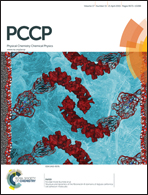Voltage induced electrochemical reactions in the single lithium-rich layer-oxide nanoparticles†
Abstract
As a crucial building block of the electrode in the lithium-ion battery (LIB), single nanoparticles that respond to an electric field have rarely been characterized experimentally. It is important to study the intrinsic properties of nanoparticles independently, excluding the effects from binders and additives. In this paper, isolated Li-rich layer-oxide (Li1.2Mn0.54Ni0.13Co0.13O2) nanoparticles are studied in comparison with individual Li2MnO3 and LiNi1/3Co1/3Mn1/3O2 nanoparticles. The bias triggered changes in morphology and material properties are characterized using dual-frequency scanning probe microscopy (SPM) techniques in ambient air, synthetic air, and an argon atmosphere. Inhomogeneous stiffness/composition is observed on single nanoparticles. The change in local Li+-ion concentration may contribute to the stiffness variation. Bias induced Li+-ion redistributions and electrochemical reactions are observed. Nanoparticles are fragmented at high voltage (>5 V) when an excessive amount of Li-ions are removed. This work further demonstrates the application of multi-frequency SPM techniques for the characterization of nanoparticles for energy storage applications.



 Please wait while we load your content...
Please wait while we load your content...